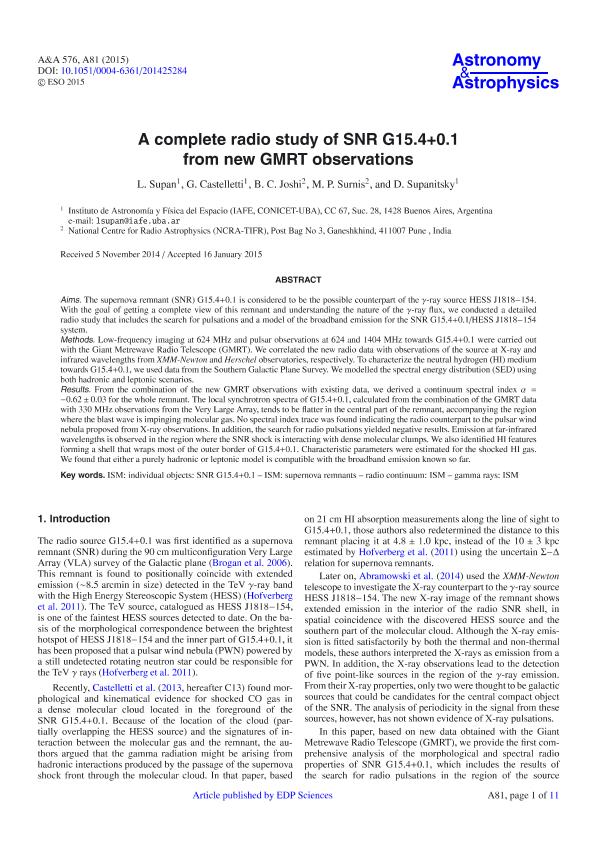Artículo
A complete radio study of SNR G15.4+0.1 from new GMRT observations
Supán, Jorge Leonardo ; Castelletti, Gabriela Marta
; Castelletti, Gabriela Marta ; Joshi, B. C.; Surnis, M. P.; Supanitsky, Alberto Daniel
; Joshi, B. C.; Surnis, M. P.; Supanitsky, Alberto Daniel
 ; Castelletti, Gabriela Marta
; Castelletti, Gabriela Marta ; Joshi, B. C.; Surnis, M. P.; Supanitsky, Alberto Daniel
; Joshi, B. C.; Surnis, M. P.; Supanitsky, Alberto Daniel
Fecha de publicación:
01/2015
Editorial:
Edp Sciences
Revista:
Astronomy and Astrophysics
ISSN:
0004-6361
Idioma:
Inglés
Tipo de recurso:
Artículo publicado
Clasificación temática:
Resumen
Aims. The supernova remnant (SNR) G15.4+0.1 is considered to be the possible counterpart of the γ-ray source HESS J1818−154. With the goal of getting a complete view of this remnant and understanding the nature of the gamma-ray flux, we conducted a detailed radio study that includes the search for pulsations and a model of the broadband emission for the SNR G15.4+0.1/HESS J1818−154 system. Methods. Low-frequency imaging at 624 MHz and pulsar observations at 624 and 1404 MHz towards G15.4+0.1 were carried out with the Giant Metrewave Radio Telescope (GMRT). We correlated the new radio data with observations of the source at X-ray and infrared wavelengths from XMM-Newton and Herschel observatories, respectively. To characterize the neutral hydrogen (HI) medium towards G15.4+0.1, we used data from the Southern Galactic Plane Survey. We modelled the spectral energy distribution (SED) using both hadronic and leptonic scenarios. Results. From the combination of the new GMRT observations with existing data, we derived a continuum spectral index alpha = -0.62 +- 0.03 for the whole remnant. The local synchrotron spectra of G15.4+0.1, calculated from the combination of the GMRT data with 330 MHz observations from the Very Large Array, tends to be flatter in the central part of the remnant, accompanying the region where the blast wave is impinging molecular gas. No spectral index trace was found indicating the radio counterpart to the pulsar wind nebula proposed from X-ray observations. In addition, the search for radio pulsations yielded negative results. Emission at far-infrared wavelengths is observed in the region where the SNR shock is interacting with dense molecular clumps. We also identified HI features forming a shell that wraps most of the outer border of G15.4+0.1. Characteristic parameters were estimated for the shocked HI gas. We found that either a purely hadronic or leptonic model is compatible with the broadband emission known so far.
Archivos asociados
Licencia
Identificadores
Colecciones
Articulos(IAFE)
Articulos de INST.DE ASTRONOMIA Y FISICA DEL ESPACIO(I)
Articulos de INST.DE ASTRONOMIA Y FISICA DEL ESPACIO(I)
Citación
Supán, Jorge Leonardo; Castelletti, Gabriela Marta; Joshi, B. C.; Surnis, M. P.; Supanitsky, Alberto Daniel; A complete radio study of SNR G15.4+0.1 from new GMRT observations; Edp Sciences; Astronomy and Astrophysics; 576; A81; 1-2015; 1-11
Compartir
Altmétricas



